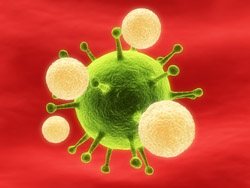Behind the scenes of viral immunity
Toll-like receptors (TLRs) are membrane-bound receptor proteins that recognise molecular patterns of certain infectious agents. They represent the first line of innate immunity against invading pathogens. TLRs binding to bacterial molecules are localised on the cell membrane while those that bind foreign nucleic acids are found in the cellular endosomes. Upon binding, intracellular signalling cascades trigger the activation of transcription factors that initiate the expression of host defence mechanisms. So far, 10 human receptors have been identified, but it is believed that more receptors and ligands exist. Aiming to broaden understanding on the mechanisms of TLR action, the EU-funded project ‘Dissecting pathogen recognition complexes of toll-like receptors: hunting for new co-receptors and ligands’ (Tollicor) set out to identify novel interactors of endosomal TLRs. Following an interdisciplinary strategy with molecular and cell biology techniques, receptor complexes were analysed and putative novel interactors of endosomal TLRs were selected. The CD14 molecule was found to interact with endosomal TLRs and to promote signalling by secretion of pro-inflammatory cytokines. Delineation of the mechanism indicated that CD14 was required for efficient uptake of foreign DNA but not of bacteria and viruses. Additionally, soluble recombinant CD14 protein was shown to enhance endosomal TLR activation and a monoclonal antibody to block such a response. Overall, the dual role of CD14 in nucleic acid uptake and as endosomal TLR co-receptor is of significant interest for the scientific and medical community. Autoimmune diseases, cancer and vaccination are closely linked to TLRs and will benefit from the findings of the Tollicor project. Tuning of CD14 activity may prove a useful approach to treating immune-response related diseases.







